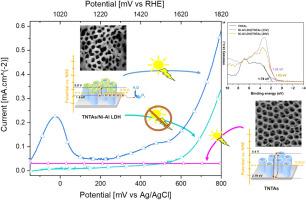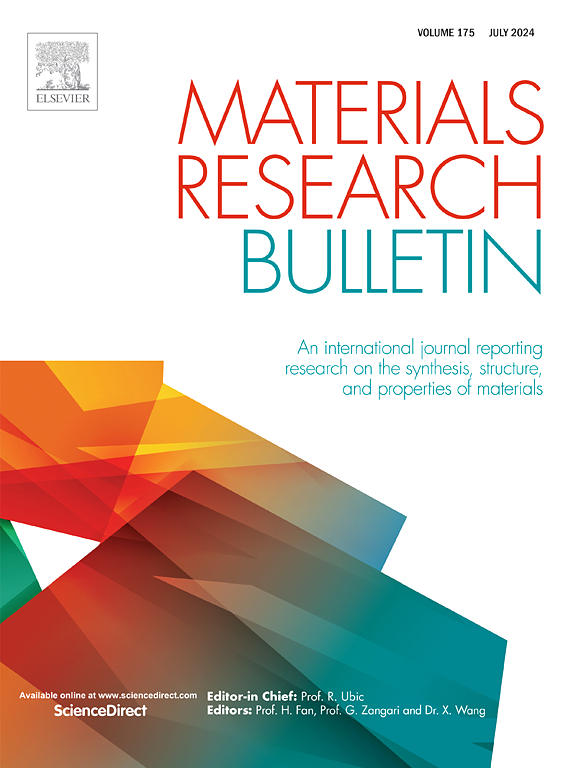Boosted photoelectrochemical activity of anodic titanium dioxide nanotubes by electrophoretically decorated nickel–aluminum layered double hydroxide
IF 5.3
3区 材料科学
Q2 MATERIALS SCIENCE, MULTIDISCIPLINARY
引用次数: 0
Abstract
The splitting of water using photoelectrochemical (PEC) processes is a promising method for generating renewable hydrogen. However, the practical efficiency of converting solar energy to fuel in PEC systems remains limited by inadequate light absorption and the swift recombination of photogenerated charge carriers within the photoelectrode material. In our research, we present a photoanode that addresses these challenges. In this work, we report on the electrophoretic deposition of nickel–aluminum layered double hydroxide (NiAl-LDH) under different voltages onto anodic TiO2 nanotube arrays (TNTAs) as a convenient and economically viable fabrication route of versatile and durable photoanodes. PEC and optical spectroscopy examinations, including linear sweep voltammetry, electrochemical impedance spectroscopy, Mott-Schottky plots, and diffuse reflectance spectroscopy, reveal that NiAl-LDH/TNTAs composites exhibit a superior enhancement of visible light absorption and consequently water splitting photocurrent. We interpret the improvement of PEC water splitting performance of the NiAl-LDH/TNTAs with the band structure speculated by the binding energy and the flat-band potential and band-gap measurements which features this nanocomposite as a novel photocatalyst for future hydrogen energy applications.

电泳修饰镍铝双层氢氧化物提高阳极二氧化钛纳米管的光电化学活性
利用光电化学(PEC)过程进行水分裂是一种很有前途的生成可再生氢的方法。然而,由于光吸收不足以及光生电荷载流子在光电极材料内迅速重组,PEC 系统将太阳能转化为燃料的实际效率仍然受到限制。在我们的研究中,我们提出了一种光阳极来应对这些挑战。在这项工作中,我们报告了在不同电压下将镍铝层状双氢氧化物(NiAl-LDH)电泳沉积到阳极二氧化钛纳米管阵列(TNTAs)上的方法,这是一种方便且经济可行的多功能耐用光阳极制造途径。包括线性扫描伏安法、电化学阻抗光谱法、Mott-Schottky 图和漫反射光谱在内的 PEC 和光学光谱检测结果表明,NiAl-LDH/TNTAs 复合材料对可见光的吸收以及由此产生的水分裂光电流均有显著增强。我们根据结合能、平带电位和带隙测量所推测的能带结构来解释 NiAl-LDH/TNTAs PEC 水分离性能的提高,这种纳米复合材料是未来氢能应用的一种新型光催化剂。
本文章由计算机程序翻译,如有差异,请以英文原文为准。
求助全文
约1分钟内获得全文
求助全文
来源期刊

Materials Research Bulletin
工程技术-材料科学:综合
CiteScore
9.80
自引率
5.60%
发文量
372
审稿时长
42 days
期刊介绍:
Materials Research Bulletin is an international journal reporting high-impact research on processing-structure-property relationships in functional materials and nanomaterials with interesting electronic, magnetic, optical, thermal, mechanical or catalytic properties. Papers purely on thermodynamics or theoretical calculations (e.g., density functional theory) do not fall within the scope of the journal unless they also demonstrate a clear link to physical properties. Topics covered include functional materials (e.g., dielectrics, pyroelectrics, piezoelectrics, ferroelectrics, relaxors, thermoelectrics, etc.); electrochemistry and solid-state ionics (e.g., photovoltaics, batteries, sensors, and fuel cells); nanomaterials, graphene, and nanocomposites; luminescence and photocatalysis; crystal-structure and defect-structure analysis; novel electronics; non-crystalline solids; flexible electronics; protein-material interactions; and polymeric ion-exchange membranes.
 求助内容:
求助内容: 应助结果提醒方式:
应助结果提醒方式:


